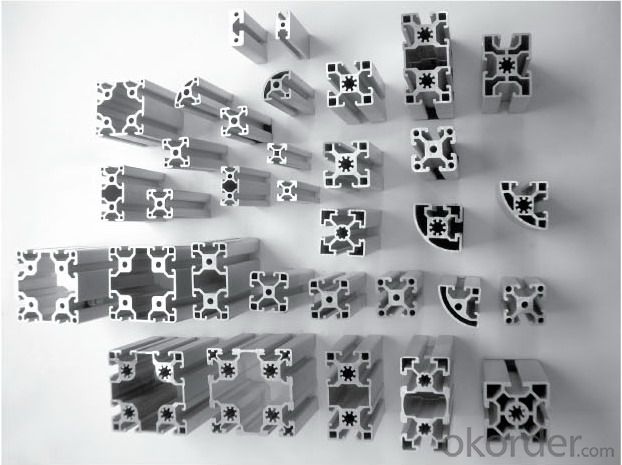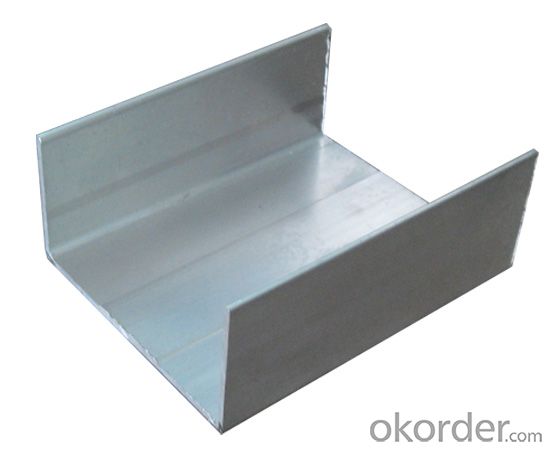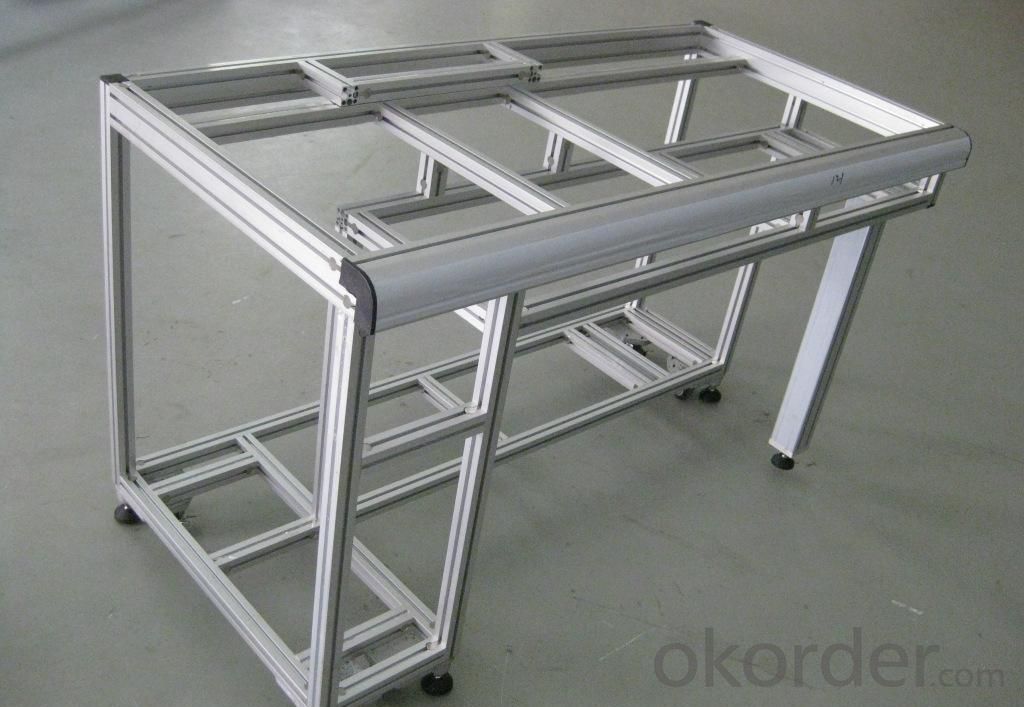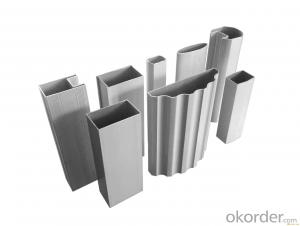Aluminium T-profile for Windows and Doors Instalation
- Loading Port:
- Shanghai
- Payment Terms:
- TT OR LC
- Min Order Qty:
- 5 m.t.
- Supply Capability:
- 2000 m.t./month
OKorder Service Pledge
OKorder Financial Service
You Might Also Like
Item specifice
Structure of Aluminium T-profile for Windows and Doors Instalation Description:
Coated aluminum coil/sheet are of a wide range of colors, which gives wonderful appearance no matter in residential and commercial constructions of great exhibition centers.
The coated aluminum coil/sheet have been widely used in the fields of construction and decoration( garage doors, ceiling etc.), electronic appliances, lighting decoration, air-condition air pipes, sandwich panels and drainages etc.
Main Features of the Aluminium T-profile for Windows and Doors Instalation:
1) High flexibility
2) Impact resistance
3) Excellent weather-proof durability
4) Anti-ultraviolet
5) High erosion resist
Images of the Aluminium T-profile for Windows and Doors Instalation:



Aluminium T-profile for Windows and Doors Instalation Specification:
Alloy | A1100,A3003,A1050,A8011 etc |
Temper | H16,H18,H24 |
Thickness | From 0.024mm to 1.2mm |
Width | Standard width:1240mm |
Special width:1300mm,1520mm,1570mm,1595mm | |
Diameter | Standard dia:1200mm |
Interior dia:150mm,405mm,505mm | |
Weight | 2.5 T/coil,3.0 T/coil |
Coating | PE, PVDF, AC |
Surface | Embossed, mill finish, coated |
Color | AS to code RAL |
Gloss | 10-90%(EN ISO-2813:1994) |
Coating Thickness | PE: more than 18 micron |
PVDF: more than 25 micron | |
Coating Hardness (pencil resistance) | More than 2h |
Coating adhesion | 5J(EN ISO-2409:1994) |
Impact Resistance | No peeling or cracking(50 kg/cm,ASTMD-2794:1993) |
Flexibility (T-bend) | 2T |
MEK resistance | More than 100 |
FAQ Aluminium Cast Slab not Alloyed in Coil Form:
a.What is monthly capacity
---CNBM is one stated own company and our monthly capacity is about 2000tons.
b. Now which countries do you export your goods?
---Now we export to South East Asia,Africa, North America,South America ect.
- Q:Aluminum profile connecting piece
- Very little to buy this alone, and only with industrial aluminum suppliers. - selling on Taobao is also a way if the price is appropriate.
- Q:What are the different surface patterns available for aluminum profiles?
- There are several different surface patterns available for aluminum profiles, each offering unique aesthetic and functional benefits. Some of the most commonly used surface patterns include: 1. Smooth: This is the most basic surface pattern, with a smooth and polished finish. It provides a sleek and modern appearance, making it ideal for applications where aesthetics are important. 2. Brushed: This surface pattern is characterized by fine lines or brush strokes running in a single direction. It creates a textured and satin-like appearance, which is often chosen for its contemporary and industrial appeal. 3. Anodized: Anodizing is an electrochemical process that creates a durable and corrosion-resistant surface on aluminum profiles. It can be customized to produce various colors and finishes, such as matte, glossy, or metallic. 4. Powder-coated: Powder coating involves applying a dry powder onto the aluminum surface and then heating it to create a smooth and durable finish. This process allows for a wide range of colors and textures, including matte, glossy, and textured finishes. 5. Wood grain: By using a specialized printing process, aluminum profiles can be made to mimic the appearance of wood. This surface pattern offers the natural and warm look of wood, while providing the benefits of aluminum, such as durability and low maintenance. 6. Textured: Aluminum profiles can also be given a textured surface pattern, which can range from a fine sand-like texture to a more pronounced embossed or hammered look. Textured surfaces not only enhance the visual appeal but also provide better grip and slip resistance. These are just a few examples of the many surface patterns available for aluminum profiles. The choice of surface pattern depends on the specific application requirements, desired aesthetics, and functional needs.
- Q:Aluminum 3100-6063-T5, please
- Aluminum in the industry according to material characteristics, such as hardness, strength, corrosion resistance and other categories, there are 8 main series, each series with 4 figures as a brand, and subdivided into many types1 series industrial pure aluminum: 1XXX2 series superhard aluminum material: 2XXX3 series easy cutting aluminum material: 3XXX4 series easy cutting aluminum material: 4XXX5 series magnesium aluminum alloy: 5XXX6 series anodic oxidation and corrosion resistant aluminum: 6XXX7 Series aviation ultra hard aluminum: 7XXX8 series: 8XXXYou say 3100-6063-T5 may contain the 3 and 6 series, easy to cut and resistant to corrosion,.T5 indicates hardness levels
- Q:How can I control the hardness of 6063 aluminum profile at 6-9 degrees?
- Classification: extension material, non heat treatment alloy and heat treatment alloy1.1 non heat treated alloys: pure aluminum - 1000 series, Al Mn alloy - 3000 series, Al Si alloy - 4000 series, Al Mg alloy - 5000 Series1.2 heat treatment of Al Cu Mg alloy alloy: 2000, aluminum magnesium silicon alloy - 6000 series aluminium zinc magnesium alloy - 7000.Two, alloy number: China's current general is the American Aluminum Association "Aluminium Association" numberExamples are as follows: 1070-H14 (pure aluminum)2017-T4 (heat treatment alloy)3004-H32 (non heat treated alloy)2.1 first digit: indicates the main addition of alloying elements1: pure aluminum2: the main alloy element added copper3: the main alloying elements are manganese or manganese and magnesium4: the main alloy element is added silicon5: the main alloying element is magnesium6: mainly add alloy elements for silicon and magnesium7: the main alloying elements are zinc and magnesium8: a new alloy that does not belong to the above alloy series2.2, second digits: an alloy that indicates the addition of alloying elements or impurities in the original alloy0: table alloy1: table original alloy by the first amendment2: table original alloy after second modifications2.3, third, and four digits:Pure aluminum: represents the original alloyAlloy: the designation of individual alloys"- >: the back of Hn or Tn indicates the condition of work hardening or the symbol of heat treatment state-Hn: indicating the symbol for non heat treated alloys-Tn: a symbol for heat treatment alloysHeat treatment of 2 aluminium and aluminium alloyA chain symbol: if the alloy element is added, it is not enough to meet the requirements, but still needs cold processing, quenching and agingTreatment and soft burning to obtain the required strength and performanceAs a result of quenching and tempering, the result of quenching and tempering is chain
- Q:Are there any fire safety considerations for using aluminum profiles?
- Fire safety considerations must be taken into account when using aluminum profiles. Although aluminum itself is not combustible, it can still contribute to the spread and intensity of a fire if not adequately protected or used in suitable applications. One important factor to consider is applying fire-resistant coatings or treatments to the aluminum profiles. These coatings can enhance the profiles' fire resistance, reducing the likelihood of ignition and slowing down the flames' propagation. Fire-resistant coatings also play a crucial role in preventing the release of toxic gases or fumes during a fire, ensuring the safety of occupants. Furthermore, when incorporating aluminum profiles into structures, their proximity to potential fire sources or ignition points should be carefully evaluated. Implementing appropriate measures for fire compartmentation and separation is crucial to hinder the rapid spread of fire. Depending on the specific application and building codes, these measures may involve using fire-resistant barriers, firestops, or fire-rated walls. Moreover, selecting fire-resistant materials for components used in conjunction with aluminum profiles is of utmost importance. This includes opting for fire-rated glass, insulation materials, and sealants that can withstand high temperatures and impede the fire's advancement. Regular maintenance and inspection of aluminum profiles are also critical to ensure their fire safety. This involves thorough checks for damages, corrosion, or wear that could compromise their performance during a fire event. In conclusion, while aluminum profiles can be used safely in various applications, it is essential to consider fire safety measures and comply with building codes and regulations to minimize the risk of fire incidents. Seeking guidance from fire safety experts or consultants can provide valuable assistance in implementing appropriate fire safety considerations when utilizing aluminum profiles.
- Q:Many aluminum extrusions are edge banding materials. What special advantages do they have for opening materials?.
- Most brands have more openings. For example, New River aluminum material, the United States and aluminum, Zhong Wang aluminum and so on. Obviously, the sealing material has advantages. It's more popular now.
- Q:You need is the extrusion machine section now has Liaoning Zhong Wang Liaoyuan Midas Nanshan aluminum aluminum Hunan Sheng Guangxi jungle SWA South northeast light alloy etc. they have more than 4500 tons of extrusion machine mainly produces large section comprises a track body profile LED lamp shell container ship with large cross section conductor rail section I is a seamless tube a market analyst if you have aluminum industrial material need to be aware of the problem you can consult me as friends.
- 4500T is not very large extrusion machine, a little aluminum factory are generally, in the hope of Liaoning, Qinghai Guoxin, Yun ore has more than 10000 tons of production lines, more than sixty percent domestic aluminum production is Guangdong Foshan, there are several manufacturers have the production line, such as Albert, Jianmei so, need to understand the aluminum things to find the best side to understand
- Q:What industries commonly use aluminum profiles?
- Industries commonly using aluminum profiles include construction, automotive, aerospace, electronics, furniture, and renewable energy.
- Q:Are aluminum profiles suitable for use in automotive body structures?
- Automotive body structures can indeed utilize aluminum profiles effectively. Aluminum, being a lightweight and durable material, offers numerous advantages in the automotive industry. Its high strength-to-weight ratio makes it an ideal option for constructing body frames, panels, and other structural components. The utilization of aluminum profiles in automotive body structures brings several benefits. Firstly, it enhances fuel efficiency by reducing the overall weight of the vehicle. This, in turn, leads to improved acceleration and handling. Moreover, aluminum exhibits exceptional corrosion resistance, allowing it to withstand harsh environmental conditions and increase the lifespan of the vehicle. Additionally, aluminum profiles can be easily shaped and molded into intricate designs, providing greater flexibility in automotive body structures. This versatility enables manufacturers to create more visually appealing and aerodynamic vehicles. While aluminum profiles offer a multitude of advantages, there are also some considerations to bear in mind. Aluminum can be more costly than traditional steel, potentially impacting the overall cost of the vehicle. Furthermore, the repair and maintenance of aluminum structures may require specialized equipment and expertise. Nevertheless, these factors are outweighed by the benefits aluminum profiles bring to the automotive industry. In conclusion, aluminum profiles are indeed suitable for use in automotive body structures due to their lightweight, durable, corrosion-resistant properties, and design flexibility. These characteristics make them an excellent choice for constructing modern vehicles.
- Q:Can aluminum profiles be used in the production of consumer electronics?
- Consumer electronics production can make use of aluminum profiles, which possess qualities such as lightness, strength, and durability. These attributes render aluminum profiles appropriate for diverse purposes within the electronics sector. For instance, they can serve as housings or enclosures for smartphones, laptops, tablets, and audio equipment. The adaptability of aluminum profiles facilitates customization and seamless integration of components, guaranteeing optimal performance and safeguarding of electronic devices. Moreover, these profiles can undergo anodization or coating processes to acquire a polished appearance and increased resistance to corrosion. This further enhances their attractiveness in the realm of consumer electronics manufacturing.
1. Manufacturer Overview |
|
|---|---|
| Location | |
| Year Established | |
| Annual Output Value | |
| Main Markets | |
| Company Certifications | |
2. Manufacturer Certificates |
|
|---|---|
| a) Certification Name | |
| Range | |
| Reference | |
| Validity Period | |
3. Manufacturer Capability |
|
|---|---|
| a)Trade Capacity | |
| Nearest Port | |
| Export Percentage | |
| No.of Employees in Trade Department | |
| Language Spoken: | |
| b)Factory Information | |
| Factory Size: | |
| No. of Production Lines | |
| Contract Manufacturing | |
| Product Price Range | |
Send your message to us
Aluminium T-profile for Windows and Doors Instalation
- Loading Port:
- Shanghai
- Payment Terms:
- TT OR LC
- Min Order Qty:
- 5 m.t.
- Supply Capability:
- 2000 m.t./month
OKorder Service Pledge
OKorder Financial Service
Similar products
New products
Hot products
Related keywords






























